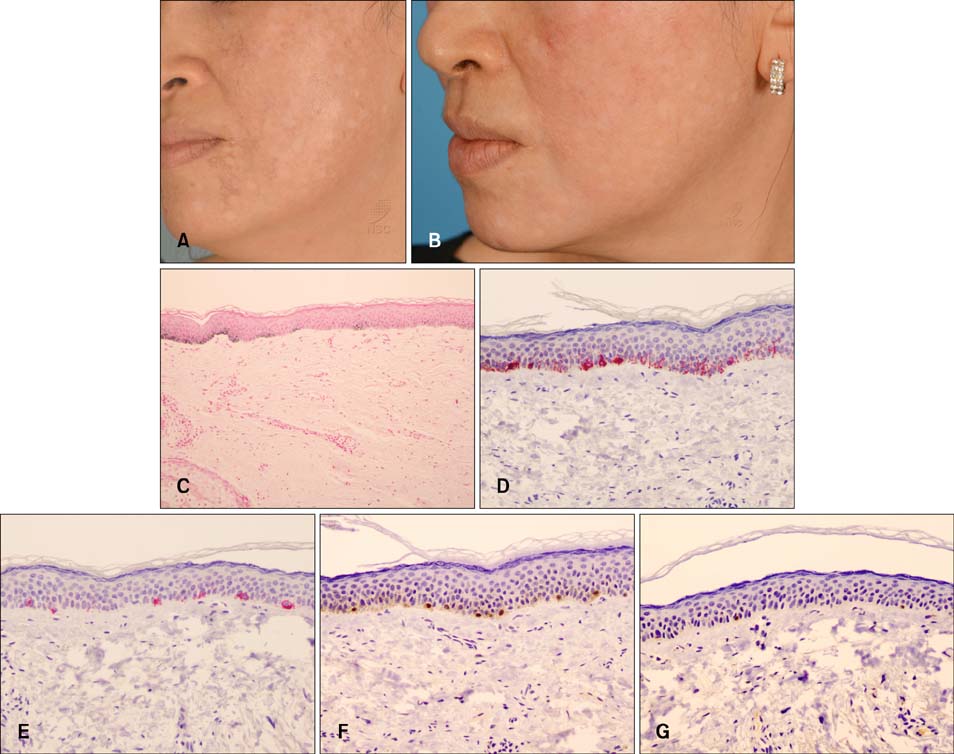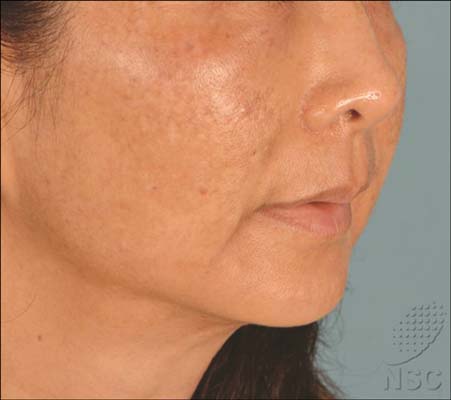Ann Dermatol.
2015 Dec;27(6):751-755. 10.5021/ad.2015.27.6.751.
Hypopigmentation Induced by Frequent Low-Fluence, Large-Spot-Size QS Nd:YAG Laser Treatments
- Affiliations
-
- 1National Skin Centre, Singapore, Singapore. yswong@nsc.gov.sg
- KMID: 2157454
- DOI: http://doi.org/10.5021/ad.2015.27.6.751
Abstract
- The Q-switched 1064-nm neodymium-doped yttrium aluminum garnet (QS 1064-nm Nd:YAG) laser is increasingly used for nonablative skin rejuvenation or "laser toning" for melasma. Multiple and frequent low-fluence, large-spot-size treatments are used to achieve laser toning, and these treatments are associated with the development of macular hypopigmentation as a complication. We present a case series of three patients who developed guttate hypomelanotic macules on the face after receiving laser toning treatment with QS 1064-nm Nd:YAG.
Figure
Cited by 2 articles
-
Analysis of Clinical Features and Treatment Outcomes Using 1,064-nm Nd-YAG Laser with Topical Hydroquinone in Patients with Riehl's Melanosis: A Retrospective Study in 10 Patients
Chong Won Choi, Gwanghyun Jo, Dong Hun Lee, Seong Jin Jo, Cheol Lee, Je-Ho Mun
Ann Dermatol. 2019;31(2):127-132. doi: 10.5021/ad.2019.31.2.127.Treatment of Laser Therapy-Induced Punctate Leukoderma Using a 308-nm Excimer Laser
Han Mi Jung, Hyub Kim, Ji Hae Lee, Gyong Moon Kim, Jung Min Bae
Ann Dermatol. 2017;29(5):630-632. doi: 10.5021/ad.2017.29.5.630.
Reference
-
1. Chan HH, Fung WK, Ying SY, Kono T. An in vivo trial comparing the use of different types of 532 nm Nd:YAG lasers in the treatment of facial lentigines in Oriental patients. Dermatol Surg. 2000; 26:743–749.
Article2. Kim JH, Kim DH, Kim JH, Lee SG, Kim HS, Park HC, et al. Recovery of pigmentation following selective photothermolysis in adult zebrafish skin: clinical implications for laser toning treatment of melasma. J Cosmet Laser Ther. 2012; 14:277–285.
Article3. Sim JH, Park YL, Lee JS, Lee SY, Choi WB, Kim HJ, et al. Treatment of melasma by low-fluence 1064 nm Q-switched Nd:YAG laser. J Dermatolog Treat. 2014; 25:212–217.
Article4. Hwang CY, Lin CS, Tseng ML, Liu HN. Spotted leucoderma after treatment of facial hyperpigmentation on hemodialysis patients employing 1064-nm Q-switched Nd:YAG laser. J Cosmet Laser Ther. 2010; 12:47–50.
Article5. Ryu HJ, Kim J. A case of mottled hypopigmentation after low-fluence 1,064-nm Q-switched neodymium-doped yttrium aluminum garnet laser therapy. J Cosmet Laser Ther. 2013; 15:290–292.
Article6. Grimes PE, Bhawan J, Kim J, Chiu M, Lask G. Laser resurfacing-induced hypopigmentation: histologic alterations and repigmentation with topical photochemotherapy. Dermatol Surg. 2001; 27:515–520.
Article7. Liew SH, Grobbelaar A, Gault D, Sanders R, Green C, Linge C. Hair removal using the ruby laser: clinical efficacy in Fitzpatrick skin types I-V and histological changes in epidermal melanocytes. Br J Dermatol. 1999; 140:1105–1109.
Article8. Hruza GJ, Dover JS, Flotte TJ, Goetschkes M, Watanabe S, Anderson RR. Q-switched ruby laser irradiation of normal human skin. Histologic and ultrastructural findings. Arch Dermatol. 1991; 127:1799–1805.
Article9. Kim JE, Chang SE, Yeo UC, Haw S, Kim IH. Histopathological study of the treatment of melasma lesions using a low-fluence Q-switched 1064-nm neodymium:yttrium-aluminiumgarnet laser. Clin Exp Dermatol. 2013; 38:167–171.
Article10. Kim T, Cho SB, Oh SH. Punctate leucoderma after 1,064-nm Q-switched neodymium-doped yttrium aluminum garnet laser with low-fluence therapy: is it melanocytopenic or melanopenic? Dermatol Surg. 2010; 36:1790–1791.
Article11. Mun JY, Jeong SY, Kim JH, Han SS, Kim IH. A low fluence Q-switched Nd:YAG laser modifies the 3D structure of melanocyte and ultrastructure of melanosome by subcellular-selective photothermolysis. J Electron Microsc (Tokyo). 2011; 60:11–18.
Article12. Chan NP, Ho SG, Shek SY, Yeung CK, Chan HH. A case series of facial depigmentation associated with low fluence Q-switched 1,064 nm Nd:YAG laser for skin rejuvenation and melasma. Lasers Surg Med. 2010; 42:712–719.
Article13. Kim MJ, Kim JS, Cho SB. Punctate leucoderma after melasma treatment using 1064-nm Q-switched Nd:YAG laser with low pulse energy. J Eur Acad Dermatol Venereol. 2009; 23:960–962.
Article14. Wattanakrai P, Mornchan R, Eimpunth S. Low-fluence Q-switched neodymium-doped yttrium aluminum garnet (1,064 nm) laser for the treatment of facial melasma in Asians. Dermatol Surg. 2010; 36:76–87.
Article
- Full Text Links
- Actions
-
Cited
- CITED
-
- Close
- Share
- Similar articles
-
- Beneficial Effect of Low Fluence 1,064 nm Q-Switched Neodymium:Yttrium-Aluminum-Garnet Laser in the Treatment of Senile Lentigo
- Partial Unilateral Lentiginosis Successfully Treated with a High-fluence 1,064-nm Q-switched Neodymium:Yttriumaluminum-garnet Laser
- Intense Pulsed Light and Low-Fluence Q-Switched Nd:YAG Laser Treatment in Melasma Patients
- Hypopigmentation Occurred After Er: YAG Laser Resurfacing
- Analysis of Clinical Features and Treatment Outcomes Using 1,064-nm Nd-YAG Laser with Topical Hydroquinone in Patients with Riehl's Melanosis: A Retrospective Study in 10 Patients




